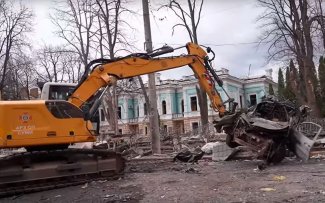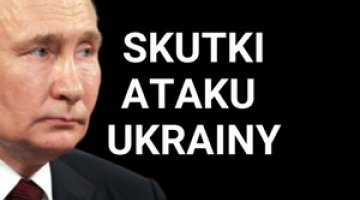Criminal Russian attacks on Sumy. Day 1147 of the war


On Palm Sunday, 13 April, Russian ballistic missiles struck Sumy, killing 35 people and injuring 125, including children (two dead and 15 injured). It was one of the deadliest attacks on a Ukrainian town since the start of full-scale aggression and the second within a week of the criminal strike on Kryvyi Rih. The first of the Iskanders hit the Sumy State University building, where a ceremony was being held to honour soldiers of the 117th Territorial Defence Brigade with the participation of servicemen – including those from other units – and civilians. According to preliminary data, 21 civilians were killed and more than 20 wounded in the incident. Among the soldiers killed was the commander of the 27th Rocket Artillery Brigade equipped with HIMARS launchers (the total number of killed and wounded soldiers was not made public).
The tragedy was caused by the explosion of a second missile over a residential area, about 200 m from the first target. According to the Interior Ministry, it was most likely equipped with a fragmentation warhead. In choosing the strike, the Russians must have been aware of the eminently civilian nature of the Sumy area under attack. This makes it possible to treat the 13 April strike – like the attack on Kryvyi Rih a week earlier – as a premeditated war crime and, in political terms, as a challenge to US efforts to halt the hostilities as soon as possible.
Kharkiv was the most frequent target of Russia’s drones, with Kharkiv mainly attacking industrial facilities. As a result of the massive strike on 9 April, damage was reported to ten businesses. Damage to facilities was also reported on 8, 12, 13 and 14 April. Also attacked were Dnipro (8, 10 and 12 April; the first two attacks injured 14 and nine people respectively, one person was killed), Kyiv (10 and 12 April), Mykolaiv (10 April), Sumy (12 and 14 April) and Odesa (13 and 14 April; seven people were injured in the second attack). From the evening of 8 April until the morning of 15 April, the invaders used a total of 496 drones. The defenders announced the downing of 306 drones with 136 were locationally lost. The enemy was said to have used nine missiles (most likely only Iskander-M ballistic missiles) during this period, none of which were shot down.

The Russians intensified their operations between the Toretsk and Pokrovsk agglomerations, pushing on both sides of the road from Donetsk to Kramatorsk and Sloviansk (via the Kostiantynivka junction). They penetrated Ukrainian positions up to 5 km deep on a front more than 10 km wide. They also pushed the defenders out of more quarters in Toretsk and from positions on the north-western outskirts of that town along the road to Kostiantynivka. They expanded the controlled area between Pokrovsk and Velyka Novosilka at a slow pace. They also made advances south of Pokrovsk, as well as east of Myrnohrad. According to some sources, they drove the defenders from their next positions in the Kupiansk area (Russia is thought to have intensified the construction of crossings over the Oskil River), in the Lyman direction, in Chasiv Yar and in the Zaporizhzhia Oblast, where they intensified their operations in the vicinity of the town of Kamensky, situated on the Dnipro River (on the road to Zaporizhzhia).
Russian forces continued their assault on enemy positions on the border of the Kursk and Sumy Oblasts. The Ukrainians hold on to two Kursk Oblast settlement (Oleshnya and Gornal), over which fighting continues, and to a forest mass in the border area of Belgorod Oblast. The Russians have made further advances in Sumy Oblast, widening and deepening the controlled area. However, they failed to break through the defences north of the Sumy-Kursk road (in the area of Loknya), the achievement of which would have given them the opportunity to develop an advance deep into Sumy Oblast.

Ukrainian attacks on Russian territory were reported mainly by Russian sources. On the night of 15 April, there were massive strikes against Kursk (there was damage in the city) and Kursk Oblast, which the Russians claimed was attacked by at least 109 of at least 115 drones used by Ukraine (the above figures were reported by the Russian Defence Ministry as shoot-downs). One of the largest Ukrainian attacks is thought to to have taken place on 9 April, on which date the Russians claimed to have downed 158 drones. It is thought that the Mozdok military airfield was among the targets, but there is no information on the impact of the strike.

On 11 April, the 27th meeting of states supporting Ukraine militarily took place in the Ramstein format. It was held for the first time under the joint chairmanship of the UK and Germany. In terms of the number of participants, it was the smallest ever. It was attended by representatives of 40 of the 57 countries making up the format, including – online – US Secretary of Defence Pete Hegseth, despite previous media reports that he would not attend.
At the meeting, the UK and Norway announced a joint support package worth £450 mn (including £350 mn from the UK). The funds come from amounts previously pledged by London and Oslo to assist Kyiv in 2025 and are to be used for “massive deliveries/hundreds of thousands” of FPV drones (manufactured in the UK and Ukraine), the refurbishment and maintenance of equipment and transport assets, and anti-tank radars and mines. Norwegian Defence Minister Tore O. Sandvik also announced his readiness to allocate “significant funds” for the purchase of artillery munitions under the so-called Czech initiative.
Germany is preparing a large support package – it plans to hand over the previously announced four IRIS-T air defence systems and 300 missiles for them, 120 mobile anti-aircraft missile sets, 15 Leopard 1 tanks, 25 Marder infantry fighting vehicles, 14 artillery systems, 300 reconnaissance drones and 100,000 artillery shells. Berlin will also provide 100 airspace surveillance radars and – “in the medium term” – 1,100 counter-battery radars. Furthermore, Defence Minister Boris Pistorius, who was in attendance, announced that Germany had transferred 30 missiles for Patriot systems to Ukraine.
New aid packages were also announced by the heads of the defence ministries of the Netherlands (€150 million for air defence), Lithuania (€20 million for ammunition) and Estonia (including 10,000 155 mm calibre artillery shells). A day before the meeting, it was revealed on the website of the Canadian UNIFIER training mission that Kyiv had received 40,000 engines from CRV-7 air-to-ground missiles scheduled for disposal (presumably for propulsion for Ukrainian ‘missile drones’). In turn, on 14 April, Defence Minister Rustem Umerov announced that Lithuania would donate €10 million to support Ukrainian production of so-called ‘long-range armaments’ (drones and missiles capable of attacking targets at least several hundred kilometres away).
Germany, along with ten other countries, has announced the formation of a new coalition to strengthen the Ukrainian army’s radio-electronic warfare capabilities. Norway officially joined the drone coalition coordinated by the UK and Latvia.
Oslo will allocate €830 million to train and equip a brigade of the Ukrainian Armed Forces, the Norwegian defence ministry has announced. A day after the meeting, it was revealed that the unit will be formed from existing subdivisions in cooperation with Northern European and Baltic states. A slightly different way of proceeding was presented by Defence Minister Sandvik, according to whom the idea is not to create a completely new unit, but to reinforce existing brigades with subdivisions that can integrate quickly.
While in Kyiv on 8 April, Prime Minister Bart De Wever announced that Belgium will deliver two F-16 fighter jets to Ukraine by the end of the year and another two in 2026. Prior to this, he stated that the start of deliveries had been postponed until next year. He also announced a €1 billion military support package. President Volodymyr Zelensky revealed after the meeting that three contracts had been signed with Belgian arms manufacturers.

In an interview with the LB.ua website on 9 April, Commander-in-Chief of the Ukrainian Army General Oleksandr Syrskyi assessed the enemy’s mobilisation potential. The size of the Russian Armed Forces grouping in Ukraine is thought to be increasing at a rate of 8–9,000 soldiers per month, which, according to Syrskyi, has resulted in an increase of 120–130,000 over the course of the year. On 1 January this year, it numbered 603,000 soldiers, and at the beginning of April it was 623,000. Recruitment to service is facilitated mainly by a high signing on payment ($20–40,000), the monthly pay of a private soldier at $2,500 and various allowances. Comparing this to the situation in the Ukrainian army, the Commander-in-Chief said: “we cannot afford it”. Russia’s mobilisation reserve is thought to include 5 million people with experience of military service, and a total of 20 million.
On 8 April, President Zelensky announced that four days earlier, two Chinese citizens fighting on the side of the Russians had been taken into Ukrainian captivity in Donetsk Oblast. He added that at least 155 Chinese nationals were serving in the Russian army, and it was possible that the number was in the hundreds. According to Ukrainian intelligence, Russia recruits ‘volunteers’ through Chinese social networks. These individuals arrive in Moscow, where they undergo a medical examination that lasts three to four days, and then remain for one to two months in training centres near the front.
The Ukrainian Foreign Ministry summoned China’s chargé d’affaires, demanding an explanation. The Chinese foreign ministry said it was checking the information provided, and stressed that it had always appealed to its citizens to refrain from participating in any armed conflict in any form. It dismissed as “completely unfounded” Kyiv’s allegations of “many Chinese citizens fighting on the side of Russian forces in Ukraine”. The government’s publicity of Chinese involvement in the war serves to undermine Beijing’s official position of declaring no involvement in the armed conflict. It also sends a signal to Washington that China is actively supporting Russian aggression.

On 8 April, the State Bureau of Investigation presented an updated algorithm for dealing with soldiers who have voluntarily left their unit. If the absence lasted up to three days, no criminal proceedings are initiated and the soldier can return to the unit he left. If it lasted more than three days, then – if it is the first time it has happened – the soldier who wants to return to duty personally reports via the Army+ application to the unit commander and receives permission. In addition, he submits an application to the public prosecutor, the pre-trial investigation authority (e.g. the police) or the court about his intention to return to duty and attaches the commander’s written consent. The materials are sent to the court in order to exonerate the soldier from criminal liability. Upon receipt of the court’s decision, the soldier returns to duty. If they abandon it again, criminal proceedings are initiated, an indictment is filed against the soldier and the court issues a sentence (the penalty is five to ten years’ imprisonment). According to the bureau, between 29 November 2024 and 1 March 2025, more than 21,000 soldiers returned to service.
On 10 April, the Ukrainian justice ministry said that one of the methods used to force men to register with the military registry is to restrict access to financial resources. A fine of 8,500 hryvnias (about $200) is imposed on those who fail to comply with the registration obligation. If they refuse to pay, the amount of the fine is blocked from their bank account and the holder is placed on the debtors’ register.
On 12 April, Deputy Head of the Office of the President Pavlo Palisa admitted that the programme of conscripting men aged 18–24 into the army on attractive terms has had limited effect. Fewer than 500 people have signed contracts since February. Palisa added that initially the number of applications was very high – this may be due to the belief that there would be a ceasefire later this year – but that most of those interested had given up on finalising recruitment.
On 15 April, the Ukrainian General Staff decided to shorten basic military training for some soldiers from 45 to 30 days from 1 May. It was noted that the changes are aimed at streamlining the training programme and adapting it to the personnel needs reported by military units on the frontline.





